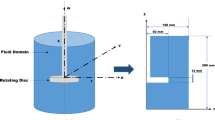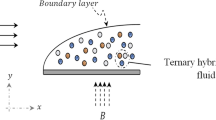Abstract
The understanding of magnetohydrodynamic phenomena associated with the flow of electrically-conducting fluid in complex ducts is important and necessary in the study of liquid-metal blankets for fusion reactor. This study numerically investigates the lead-lithium (Pb-17Li) magnetohydrodynamic (MHD) splitting flows. The effects of the splitting angle of the duct geometry, the magnetic field orientation and the partly different electrical conductivity of the structural walls on the flow characteristics are analyzed in detail. Furthermore, the combined effects of the splitting angle, the magnetic field orientation and duct electrical conductivity on the mass flow rate and pressure drop are considered with many sub-cases. The results show that the mass imbalance and the pressure drop depend on the splitting angle of the duct geometry, on the discrepancy of the electrical conductivity of the sub-channels and also on the magnetic field orientation. In a word, this study can support several approaches to improve the flow imbalance and to reduce the pressure drop in the sub-channels of the liquid-metal (LM) MHD splitting flow system.
Similar content being viewed by others
Abbreviations
- B 0 :
-
Magnetic field intensity
- Ha :
-
Hartmann number
- L :
-
Characteristic length
- m :
-
Mass flow rate
- p :
-
Pressure
- Re :
-
Reynolds number
- u :
-
Average velocity
- θ :
-
The angle of the magnetic field formed with x-axis
- μ :
-
Dynamic viscosity
- ν :
-
Kinematic viscosity
- ρ :
-
Density of the fluid
- σ :
-
Electric conductivity
- CFD :
-
Computational fluid dynamics
- EFCC :
-
Electric-field component of the current
- EMCC :
-
Electro-motive component of the current
- FCI :
-
Flow channel inserts
- LM :
-
Liquid metal
- MHD :
-
Magnetohydrodynamic
References
S. Smolentsev, R. Moreau, L. Bühler and C. Mistrangelo, MHD thermofluid issues of liquid-metal blankets: phenomena and advances, Fusion Engineering and Design, 85 (2010) 1196–1205.
L. Bühler, C. Mistrangelo and H.-J. Brinkmann, Experimental investigation of liquid metal MHD flow entering a flow channel insert, Fusion Engineering and Design, 154 (2020) 111484.
E. R. Kumar, T. Jayakumar and A. K. Suri, Overview of TBM R&D activities in India, Fusion Engineering and Design, 87 (2012) 461–465.
R. Bhattacharyay, A. Patel, R. Ellappan, P. K. Swain, P. Satyamurthy, S. Kumar, S. Ivanov, A. Shishko, E. Platacis and A. Zik, Liquid metal MHD experimental activities for LLCB TBM development, Fusion Engineering and Design, 88 (2013) 2244–2250.
C. Courtessole, S. Smolentsev, T. Sketchley and M. Abdou, MHD PbLi experiments in MaPLE loop at UCLA, Fusion Engineering and Design, 109–111 (2016) 1016–1021.
T. Zhou, Z. Meng, H. Zhang, H. Chen and Y. Song, Code validation for the magnetohydrodynamic flow at high Hartmann number based on unstructured grid, Fusion Engineering and Design, 88 (2013) 2885–2890.
Z. Yang, P. He, H. F. Yan, Z. Bin, S. S. Bao, F. Wang, M. Chen, G. Jia and X. Gong, The development of a three-dimensional finite element method code for the heat flux analysis of tungsten monoblock divertor on EAST, Fusion Engineering and Design, 152 (2020) 111448.
S. Selimli, Z. Recebli and E. Arcaklioglu, MHD numerical analyses of hydrodynamically developing laminar liquid lithium duct flow, International Journal of Hydrogen Energy, 40 (2015) 15358–15364.
C. Mistrangelo and L. Bühler, Electric flow coupling in the HCLL blanket concept, Fusion Engineering and Design, 83 (2008) 1232–1237.
S. Siriano, A. Tassone, G. Caruso and A. D. Nevo, MHD forced convection flow in dielectric and electro-conductive rectangular annuli, Fusion Engineering and Design, 159 (2020) 111773.
R. J. Singh and T. B. Gohil, The numerical analysis on the variation of electric potential, electric current and Lorentz force with its influence on buoyancy-driven conjugate heat transfer and fluid flow using OpenFOAM, Fusion Engineering and Design, 148 (2019) 111300.
T. J. Rhodes, S. Smolentsev and M. Abdou, Effect of the length of the poloidal ducts on flow balancing in a liquid metal blanket, Fusion Engineering and Design, 136 (2018) 847–851.
A. Tassone, G. Caruso and A. D. Nevo, Influence of PbLi hydraulic path and integration layout on MHD pressure losses, Fusion Engineering and Design, 155 (2020) 111517.
H. Kumamaru, Numerical analyses on liquid-metal magnetohydrodynamic flow in sudden channel contraction, Journal of Nuclear Science and Technology, 54 (2017) 1881–1248.
T. Q. Hua and J. S. Walker, MHD flow in rectangular ducts with inclined non-uniform transverse magnetic field, Fusion Engineering and Design, 27 (1995) 703–710.
C. Mistrangelo and L. Bühler, Electro-magnetic flow coupling for liquid metal blanket applications, Fusion Engineering and Design, 109–111 (2016) 1425–1457.
C. Mistrangelo and L. Bühler, MHD phenomena related to electromagnetic flow coupling, Magnetohydrodynamics, 53 (2017) 141–148.
M. Raw, Robustness of coupled algebraic multi-grid for the Navier-Stokes equations, Proc. 34th Aerospace Sciences Meeting and Exhibit, Reno (1996).
W. Z. Shen, J. A. Michelsen and J. N. Sorensen, Improved Rhie-Chow interpolation for unsteady flow computations, AIAA Journal, 39(12) (2001) 2406–2409.
ANSYS, ANSYS CFX Tutorial, ANSYS, Inc., Canonsburg PA (2010).
X. Xiao and C. N. Kim, Effects of the magnetic field direction and of the cross-sectional aspect ratio on the mass flow rate of MHD duct flows, Fusion Engineering and Design, 151 (2020) 111373.
Acknowledgments
This work was sponsored by Shanghai Sailing Program of China (Grant No. 20YF1432900).
Author information
Authors and Affiliations
Corresponding author
Additional information
Chang Nyung Kim is a Professor in Department of Mechanical Engineering, College of Engineering, Kyung Hee University, Korea. His research interests include numerical analysis of magnetohydro-dynamics and thermoelectricity.
Rights and permissions
About this article
Cite this article
Luo, Y., Chen, Y. & Kim, C.N. Study on the flow features of lead-lithium MHD splitting flows under an external magnetic field with arbitrary orientation. J Mech Sci Technol 35, 4489–4502 (2021). https://doi.org/10.1007/s12206-021-0919-z
Received:
Revised:
Accepted:
Published:
Issue Date:
DOI: https://doi.org/10.1007/s12206-021-0919-z




